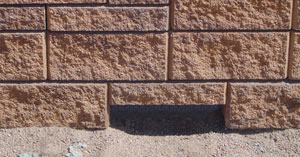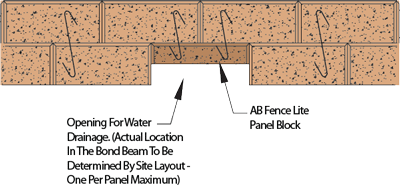Water Management

Water Drainage Option for Concrete Fence
The design and performance of most concrete fence structures are based on keeping the area around the fence relatively dry. To ensure a quality project, the soils must not become saturated during construction and the final design must route water in a manner to prevent water from building up around the structure. Incorporating berms and swales into the final block fence design is an easy way to direct surface water away from the concrete fence.
During the design process, develop a thorough understanding of the site and determine where the water will come from and how it will be properly managed. If the water cannot be diverted around or away from the fence, it may require installing an opening in the fence panel to allow the water to move under the fence. You may need to consult with an engineer to ensure that the water has been accounted for in your design.
During the building process, stage your materials so surface runoff is not directed improperly. Temporary grading may be needed to ensure water will not drain toward the construction area. It is also good practice to cover the fence area at the end of the day to prevent water saturation if rain is in the forecast.

Fence Drain Construction
- During the first course placement and at the location in the fence panel where water needs to be directed under the fence, replace one full fence panel block with an AB Fence Lite Panel Block and a wood or foam block spacer that is approximately 4 in. (100 mm) high. The block and spacer together should equal the height of one AB Fence Panel Block.
- Continue with standard bond beam construction, placing rebar and second course of block.
- Install shorter stirrups when grouting the bond beam in both cores of the AB Fence Lite Panel Block.
- Remove wood or foam spacer only when bond beam has fully cured.

